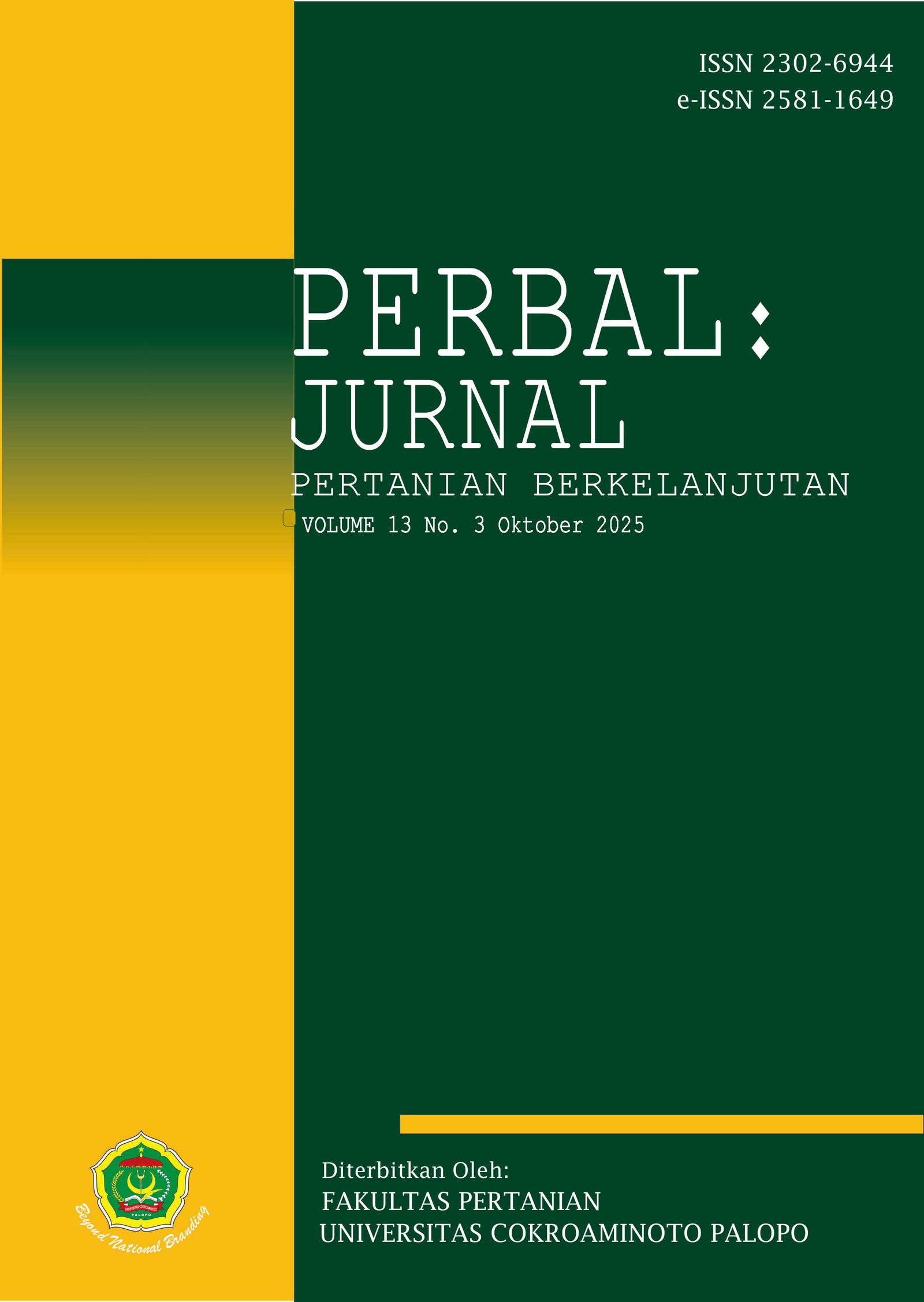Peran Pupuk Hilado (Hijau Lamtoro dan Dolomit) dalam Revitalisasi Kesuburan Lahan Bekas Tambang Aspal untuk Budidaya Padi Wakawondu
“Hilado" (Green Lamtoro and Dolomit) Fertilizer’s Role in Restoring Ex-Asphalt Mine Soil for Wakawondu Rice
DOI:
https://doi.org/10.30605/perbal.v13i3.7013Keywords:
Hilado, lamtoro, dolomit, aspal buton, wakawonduAbstract
Tanaman padi wakawondu merupakan tanaman pangan lokal unggulan masyarakat Buton khususnya Desa Lawele, Kecamatan Lasalimu. Budidaya padi lokal wakawondu sudah jarang dilakukan di lahan kering karena rendahnya hasil produksi sebagai akibat menurunnya kesuburan tanah. Penyebab menurunnya kesuburan tanah adalah adanya aktivitas pertambangan aspal yang terjadi daerah tersebut. Degradasi lahan tidak dapat dihindari sehingga ketersediaan hara tanah pada daearah tambang aspal menjadi rendah. Pemupukan menggunakan bahan organik sangat perlu dilakukan guna memperbaiki kondisi hara pada lahan tambang aspal untuk budidaya padi wakawondu. Tujuan penelitian ini adalah untuk mengetahui peran pupuk hilado (hijau lamtoro dan dolomit) dalam merevitalisasi lahan tambang aspal untuk pertumbuhan padi wakawondu. Penelitian ini dilaksanakan di Desa Lawele Kecamatan Lasalimu Kabupaten Buton. Waktu penelitian pada bulan Juni-September 2025. Penelitian ini menggunakan metode Rancangan Acak Kelompok (RAK) yang dilakukan dengan 4 perlakuan dengan 3 kali ulangan sehingga terdapat 12 unit percobaan. Taraf dosis yang digunakan yaitu P0 = tanpa perlakuan (kontrol), P1 (Dosis 25% pupuk hilado), P2 (Dosis 50% pupuk hilado), dan P3 (Dosis 75% pupuk hilado). Hasil penelitian menunjukkan bahwa aplikasi dosis pupuk hilado tidak memberikan pengaruh nyata terhadap pH tanah (7) namun memberikan pengaruh nyata terhadap tinggi tanaman 79.73, jumlah anakan 41.44, dan indeks kehijauan daun 3.83. Perlakuan terbaik terdapat pada perlakuan P2 (dosis 50% pupuk hilado) untuk semua variabel pengamatan. Hal ini diduga dosis 50% mampu mensuplai ketersedian hara bagi tanaman.
Wakawondu rice is one of the best food crops of the Buton community, particularly in Lawele Village, Lasalimu District. Its cultivation is rarely carried out on dry land due to low production yields as a result of declining soil fertility. The cause of this decline is the asphalt mining activities that occur in this area. Land degradation cannot be avoided, so the availability of soil nutrients in asphalt mining is low. Organic fertilization is therefore critical to restore soil productivity in this wakawondu cultivation area. This study aims to determine the role of Hilado fertilizer in revitalizing the asphalt mining land for wakawondu rice growth. This study was conducted in Lawele Village, Lasalimu District, Buton Regency. The research period was June to September 2025. This study used a Randomized Block Design (RBD) method, which was carried out with 4 treatments with 3 replications, so that there were 12 experimental units. The dosage levels used were P0 = no treatment (control), P1 (25% dose of Hilado fertilizer), P2 (50% dose of Hilado fertilizer), and P3 (75% dose of Hilado fertilizer). The result of the study showed that the application of Hilado fertilizer doses did not have a significant effect on soil pH (7) but had a significant effect on plant height 79.73, number of tillers 41.44, and leaf greenness index 3.83. The best treatment was in the P2 (50% dose of Hilado fertilizer) for all observation variables. It is hypothesized that the 50% application rate provides sufficient availability to support plant growth.
Downloads
References
Brady, N.C., & Weil, R.R. (2019). The Nature and Properties of Soils (15th ed.). Pearson Education.
Fikri, A., Harahap, I.S., & Siregar, R. (2021). Pengaruh aktivitas tambang terhadap sifat fisik dan kimia tanah pada lahan pascatambang. Jurnal Tanah dan Lingkungan, 23(2), 75–84.
Fitria, N. (2021). Efektivitas dosis pupuk organik cair terhadap pertumbuhan dan hasil padi sawah. Jurnal Ilmiah Agro, 28(3), 115–124.
Fitriani, N., Sari, D., & Hidayat, R. (2020). Pengaruh pupuk organik cair terhadap pertumbuhan vegetatif tanaman padi (Oryza sativa L.). Jurnal Agrotek Indonesia, 5(2), 45–52.
Halawa, N., Floretina, A.D., Awal, S.D., Lentri, P.W., Arianto, L., Benedigtus, B.G., Asdian, J.L., Helmin, P.Z. (2025). Analisis perbandingan efektivitas pupuk kimia dan pupuk organik terhadap pertumbuhan dan produktivitas tanaman cabai. Hidroponik: Jurnal Ilmu Pertanian dan Teknologi dalam Ilmu Tanaman, 2(1), 246-256. DOI: https://doi.org/10.62951/hidroponik.v2i1.278
Hardjowigeno, S. (2010). Ilmu Tanah. Jakarta: Akademika Pressindo.
Hemmler, K. S., Reimer, J., Köhler, T., & Breuer, L. (2024). Sand mining deteriorates soil fertility and farming—Impacts on agricultural land and livelihoods. Scientific Reports, 14, 11321. https://doi.org/10.1038/s41598-024-64038-5. DOI: https://doi.org/10.1038/s41598-024-66656-z
Irwanda, M. A. (2023). Pemanfaatan Pupuk Hijau Daun Lamtoro Terhadap Pertumbuhan Tanaman Pangan. Universitas Medan Area.
Nurhayati, A., Sari, D., & Rahman, H. (2020). Pengaruh pupuk organik cair terhadap pertumbuhan vegetatif padi sawah. Jurnal Agroteknologi Tropika, 9(2), 55–63.
Peliyarni, Azizu, M.N., Ridwan, & Yanti, W.R. (2022). Analisis kadar nitrogen, fosfor dan kalium pada lahan tambang aspal Buton. BioWallacea : Jurnal Penelitian Biologi (Journal of Biological Research), 9(2), 92-100. DOI: https://doi.org/10.33772/biowallacea.v9i2.27830
Putra, R.E., Rayes, M.L., Kurniawan, S., & Ustiatik, R. (2022). Pengaruh kombinasi pupuk organik dan anorganik terhadap sifat fisik dan kimia tanah serta produksi padi pada lahan kering yang disawahkan. Jurnal Agrikultura, 35(1), 10–19. DOI: https://doi.org/10.24198/agrikultura.v35i1.53686
Sadimantara, M.S., Asranudin, Holilah, Sadimantara, F.N., Asyik, N. (2019). Physicochemical and antioxidant properties of red rice varieties of wakawondu and wangkariri from North Buton, Indonesia. International Journal of Scientific & Technology Research, 8(8).
Suryana, D., & Anas, M. (2019). Respon pertumbuhan padi pada fase vegetatif terhadap berbagai dosis pupuk organik. Jurnal Pertanian Berkelanjutan, 17(1), 45–52.
Wahyuni, R., Yuliana, S., & Hidayat, A. (2018). Peran pupuk organik dalam meningkatkan pertumbuhan awal tanaman padi. Jurnal Sumberdaya Pertanian, 12(2), 33–41.
Zhang, J., Liu, X., Li, Y., Chen, H., & Wang, Q. (2023). Impacts of mining activities on the spatial distribution and quality of soil organic matter in farmlands. Environmental Research, 220, 115204. DOI: https://doi.org/10.1016/j.scitotenv.2023.163627
Downloads
Published
Issue
Section
License
Copyright (c) 2025 Peliyarni Peliyarni, Rizka Rahmahwati

This work is licensed under a Creative Commons Attribution 4.0 International License.
In submitting the manuscript to the journal, the authors certify that:
- They are authorized by their co-authors to enter into these arrangements.
- The work described has not been formally published before, except in the form of an abstract or as part of a published lecture, review, thesis, or overlay journal.
- That it is not under consideration for publication elsewhere,
- That its publication has been approved by all the author(s) and by the responsible authorities – tacitly or explicitly – of the institutes where the work has been carried out.
- They secure the right to reproduce any material that has already been published or copyrighted elsewhere.
- They agree to the following license and copyright agreement.
License and Copyright Agreement
Authors who publish with Onoma Journal: Education, Languages??, and Literature agree to the following terms:
- Authors retain copyright and grant the journal right of first publication with the work simultaneously licensed under Creative Commons Attribution License (CC BY 4.0) that allows others to share the work with an acknowledgment of the work's authorship and initial publication in this journal.
- Authors are able to enter into separate, additional contractual arrangements for the non-exclusive distribution of the journal's published version of the work (e.g., post it to an institutional repository or publish it in a book), with an acknowledgment of its initial publication in this journal.
- Authors are permitted and encouraged to post their work online (e.g., in institutional repositories or on their website) prior to and during the submission process, as it can lead to productive exchanges, as well as earlier and greater citation of published work.














